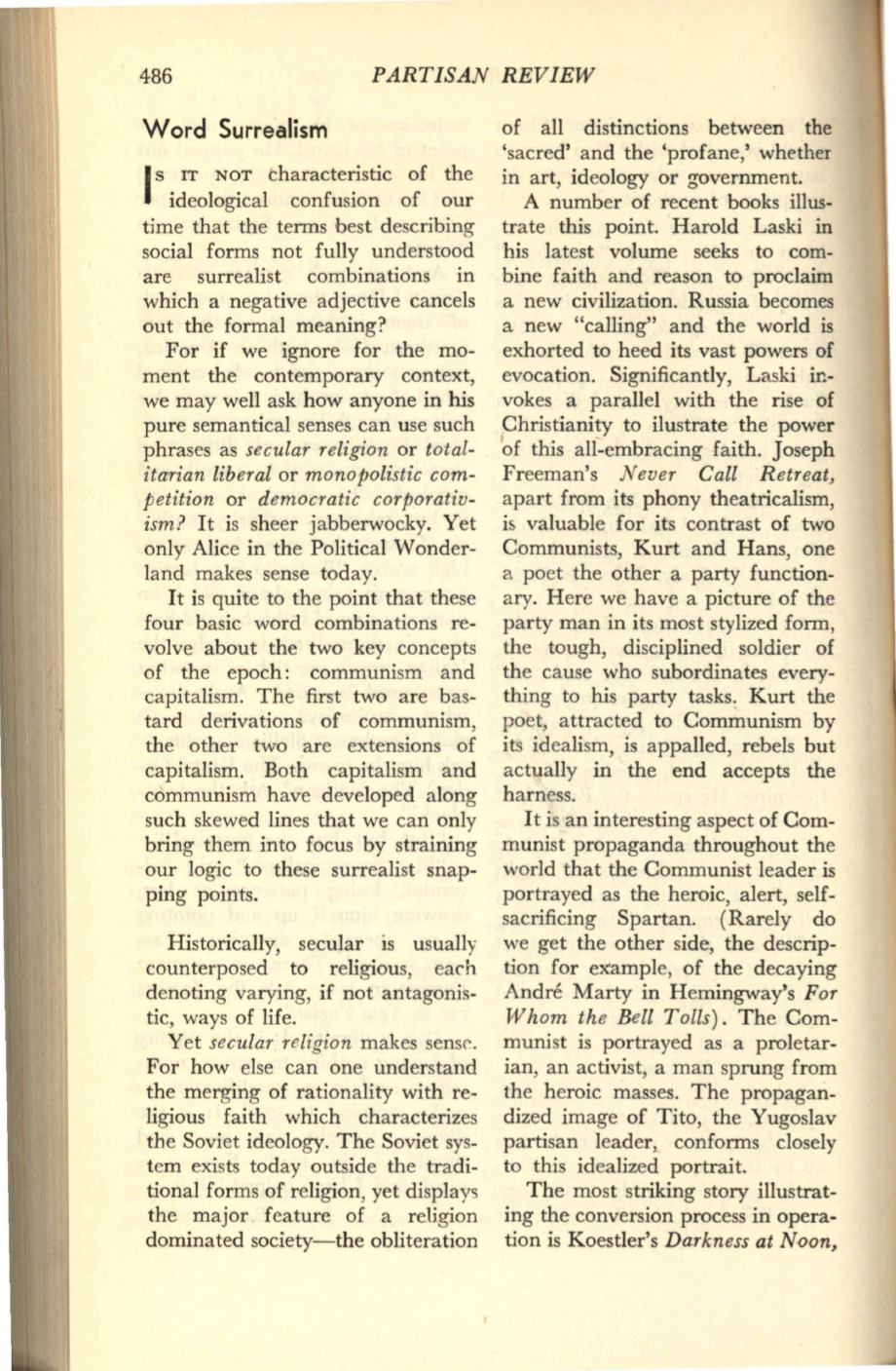
486
PARTISAN REVIEW
Word Surrealism
I
s
IT NOT
tharacteristic of the
ideological confusion of our
time that the terms best describing
social forms not fully understood
are surrealist combinations in
which a negative adjective cancels
out the formal meaning?
For if we ignore for the mo–
ment the contemporary context,
we may well ask how anyone in his
pure semantical senses can use such
phrases as
secular religion
or
total–
itarian liberal
or
monopolistic com–
petition
or
democratic corporativ–
ism?
It is sheer jabberwocky. Yet
only Alice in the Political Wonder–
land makes sense today.
It is quite to the point that these
four basic word combinations re–
volve about the two key concepts
of the epoch: communism and
capitalism. The first two are bas–
tard derivations of communism,
the other two are extensions of
capitalism. Both capitalism and
communism have developed along
such skewed lines that we can only
bring them into focus by straining
our logic to these surrealist snap–
ping points.
Historically, secular is usually
counterposed to religious, each
denoting varying, if not antagonis–
tic, ways of life.
Yet
secular religion
makes sense.
For how else can one understand
the merging of rationality with re–
ligious faith which characterizes
the Soviet ideology. The Soviet sys–
tem exists today outside the tradi–
tional forms of religion, yet displays
the major feature of a religion
dominated society-the obliteration
of all distinctions between the
'sacred' and the 'profane,' whether
in art, ideology or government.
A number of recent books illus–
trate this point. Harold Laski in
his latest volume seeks to com–
bine faith and reason to proclaim
a new civilization. Russia becomes
a
new "calling" and the world is
exhorted to heed its vast powers of
evocation. Significantly, Laski ir.–
vokes a parallel with the rise of
Christianity to ilustrate the power
of this alf-embracing faith. Joseph
Freeman's
Never Call Retreat,
apart from its phony theatricalism,
is valuable for its contrast of two
Communists, Kurt and Hans, one
a poet the other a party function–
ary. Here we have a picture of the
party man in its most stylized form,
the tough, disciplined soldier of
the cause who subordinates every–
thing to his party tasks: Kurt the
poet, attracted to Communism by
its idealism, is appalled, rebels but
actually in the end accepts the
harness.
It is an interesting aspect of Com–
munist propaganda throughout the
world that the Communist leader is
portrayed as the heroic, alert, self–
sacrificing Spartan. (Rarely do
we get the other side, the descrip–
tion for example, of the decaying
Andre Marty in Hemingway's
For
Whom the Bell Tolls).
The Com–
munist is portrayed as a proletar–
ian, an activist, a man sprung from
the heroic masses. The propagan–
dized image of Tito, the Yugoslav
partisan leader, conforms closely
to this idealized portrait.
The most striking story illustrat–
ing the conversion process in opera–
tion is Koestler's
Darkness at Noon,


